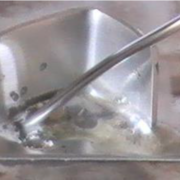Short answer: Yes, aluminum is solderable.
Soldering aluminum is not like soldering copper, which is generally easy. Soldering to Aluminum is even harder than soldering to Stainless Steel. Sure, if you look at the basic steps, it’s the same thing. You need to choose the right filler metal and right flux, clean the Aluminum to remove oxides from your solder area, heat the parts, and clean the joint after soldering. But to succeed in soldering Aluminum, it’s all in the details.
Superior Flux has the honor of having our very own Aluminum soldering guru in our midst, Mr. Bill Avery. A soldering industry veteran, he leads the charge in developing new flux and solder paste products for soldering Aluminum. With his help, here are some very important things when you want to solder to aluminum.
Consider…
Your Operators
Operators will notice differences in using an Aluminum soldering flux immediately. When the flux is heated it fumes greatly and smells like ammonia. This is because the flux needs to be strong enough to cut through the tenacious oxide layer that forms on Aluminum and to keep this oxide layer from reforming until the soldering is completed. If you are switching from copper to aluminum, you may need to add stronger ventilation, or use more robust masks to help deal with these more noxious fumes.
To date, there is no such thing as a no-clean flux for soldering Aluminum. Aluminum soldering flux MUST be cleaned off after use. Superior Flux Aluminum soldering formulations are water-soluble and we have a specialty cleaner, our Aluminum Cleaner (link) for the parts as well when extra post-solder cleaning help is needed.
Your Base Aluminum Alloy
The ability to solder to aluminum will depend IMMENSELY on what alloy is used. Aluminum alloys are numbered in such a way that you can tell which metal they are alloyed with and either their modification or purity. The general format is XXXX. The first digit is used to find the other metal in the alloy. So 1xxx is part of the 1000-series aluminum. 3xxx is alloyed with a different element and is referred to as a 3000 series aluminum alloy.
In general:
| SERIES (principle alloying element) | SOLDERABLE? |
|---|---|
| 1XXX (99%+ pure aluminum) | YES! |
| 2XXX (Copper) | Sometimes |
| 3XXX (Manganese) | YES! |
| 4XXX (Silicon) | No |
| 5XXX (Magnesium) | Rarely |
| 6XXX (Magnesium and Silicon) | Sometimes |
| 7XXX (Zinc) | Rarely |
You can find more information about the solderability of different alloys here on the Last page of our Aluminum Soldering Product Guide
Using a Solder Paste vs Separate Flux and Alloy
Are you trying to hand solder components? Or do you want to use a solder paste and then pass parts through an oven or another heating device? Solder pastes are a convenient mix of both flux and filler metal, but they ultimately restrict the amount of flux you can use, so Aluminum soldering pastes are not ideal for all applications. If a solder paste has a lot of flux, there is little room left for the metal powder. But if there is a higher metal load, there may not be enough flux to solder with. Aside from metal load, a solder paste will generally contain a binder to keep the flux from reacting with the metal. This will further dilute the flux’s effectiveness. This being said, Aluminum Solder Pastes are an excellent option for specific applications.
By using a flux that is separate from the alloy, you can use a stronger, more aggressive formula. You may also decide to add more flux partway through heating or feed additional filler metal in. The biggest advantage is that you have more control over the soldering. You can choose your desired viscosity, the amount of flux used, the amount of alloy used, and how the flux and alloy are added into the setup.
Your Heating Details
To perform the soldering, you can use all sorts of methods. Viable options are: oven, hot plate, torch, soldering iron, induction, or resistance soldering. The main thing to note though is that when you consider the temperature, you are talking about the temperature of the aluminum parts, not the oven temperature, not the temperature the hot plate is set to, the temperature of the parts. The minimum part temperature that the flux will work at is 180°C (~350°F). That’s when the active ingredients work their magic. On the opposite end, as it were, you need to get the aluminum up to temperature and finish the soldering within 8 minutes. After this, the flux begins to degrade and is spent.
Now what?
You’ve read through all that and thought even more about what you want to do, where do you go? After taking this information into consideration, what now? Don’t worry. Superior Flux is here to help.
Want even more in depth information?
- We have assorted technical papers here: Technical Papers
- We literally wrote (part of) the book for the Aluminum Association Aluminum Soldering Handbook
- What product should you look at first? Take a look at Bill’s product guide here: Product Guide – Aluminum Soldering
- Are you brazing the aluminum instead of soldering? Aluminum Brazing Fluxes
- What’s the difference? Picking a Flux
- Need a solder paste or soldering flux for your non-aluminum parts? Solder Pastes (Low-Temp, Lead-Bearing, or Lead-Free)
- No idea? Contact Us



